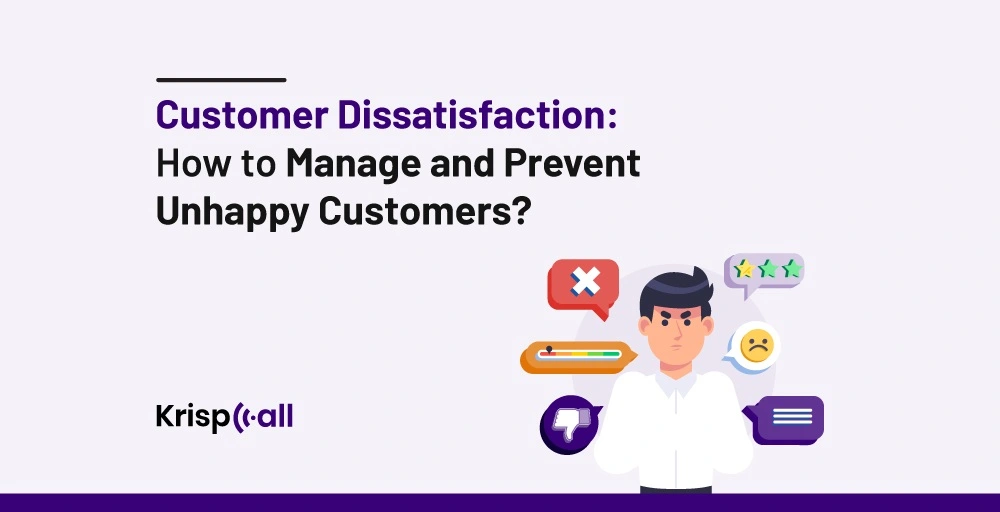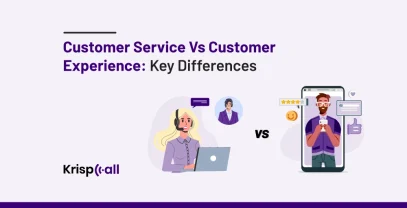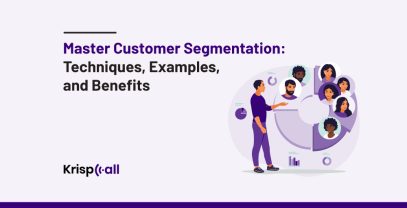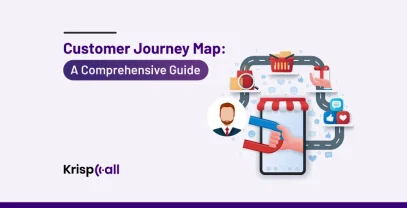It’s common for businesses to lose sales due to dissatisfied customers. Whether the problem is a product defect, service gap, or simply unmet expectations and unhappy customers, it can ruin a company’s reputation 📉 and damage its bottom line.
One research suggests that around 51 percent of customers will never return to businesses that deliver one poor customer experience. But worry not—converting your unhappy customers into loyal ones is possible.🤩
👉In this blog, you will learn some major reasons for customer dissatisfaction, common types of unhappy customers, how they impact your business operations, and how you can effectively handle customer dissatisfaction.
So, without wasting time ⏲️, let’s dive in!
🔑 KEY HIGHLIGHTS
- A Dissatisfied customer is someone who faces negative experiences with businesses.
- Active listening to customer concerns, clear and empathetic responses, and timely follow-up to resolve issues are key ways to reduce customer dissatisfaction.
- Poor customer service, unmet expectations, lack of personalization, and higher prices are some of the reasons behind unhappy customers.
- A dissatisfied customer directly impacts your business, causing damage to your reputation, lost revenue, wasted resources, and more.
- The types of unhappy customers include demanding, churned, silent, unheard, and misinformed customers.
What is Customer Dissatisfaction?
Customer dissatisfaction is the state of unhappiness or disappointment experienced by consumers due to various factors related to a product or service they have purchased. Dissatisfied customers are not only those who complain about your products and services—it’s much more than that.

Instead, customers are dissatisfied for many reasons, including poor customer service, unmet customer expectations, brand experience, ignored interactions, and more. Such dissatisfaction can lead to customers switching to competitors and companies losing potential customers.
It is estimated that 89 percent of customers will likely return to a business that provides personalized service. Therefore, companies should proactively offer customized services to ensure customer satisfaction and loyalty. This can be done using customer data to understand customer needs and preferences better.
What are the Main Reasons for Customer Dissatisfaction?
Several reasons customers might be dissatisfied include poor product quality, ineffective customer service, and pricing issues. Customer Dissatisfaction can significantly impact the business, including damaged reputation, loss of revenue, and decreased customer loyalty.
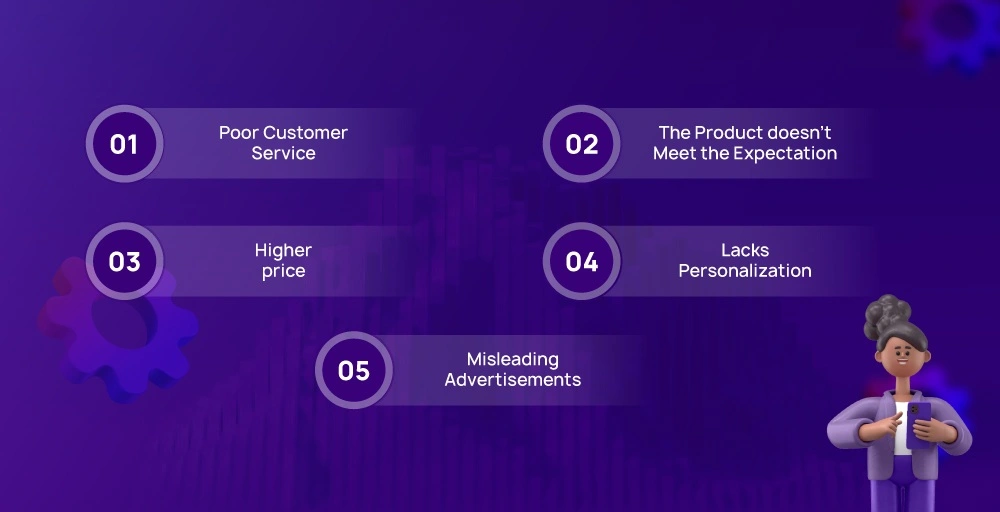
Customers are dissatisfied for several reasons. Here are some major reasons:
1. Poor Customer Service
Around 73 percent of customers shift to another brand after having a bad experience, and more than half of them shift to competitors after having one negative experience. Now, you should know why effective customer service is needed by businesses.
Poor customer service includes several aspects, which include long wait times, rude support staff, and unresolved issues. Imagine a prospect dealing with customer service with untimely responses or getting misleading information – there’s nothing more frustrating than that.
Similarly, negative interactions with customer support impact the overall customer experience. This ultimately leads to dissatisfaction, which is a business loss.
2. The Product doesn’t meet the Expectation
Businesses must know that their products and services must match customers’ expectations; if not, the result is simple—unsatisfied customers. Everyone knows that customers spend money to get quality products and services, and if the company fails to provide them, they may feel tricked or disappointed.
Poor products and services undoubtedly damage businesses’ reputations and customer trust. More customers’ negative experiences with businesses directly lead to business loss, negative reviews, decreased sales, and loss of repeat purchases.
3. Higher Price
Price is the first thing that shapes customers’ perceptions of a particular product and service. There’s nothing new when customers perceive a particular product as overpriced compared to the value it adds; they feel dissatisfied.
Customers assess many factors before purchasing from businesses. These include factors such as quality, value, features, brand reputation, and even comparing it with competitors. They will search for alternatives if they find something fishy about the product that doesn’t justify its price.
4. Lacks Personalization
Most customers prefer repeat business when they receive personalized service. Providing personalized service to each individual customer undoubtedly increases brand reputation and repeat business.
Customers expect products, services, and interactions tailored to their needs and preferences. This creates a more personal touch with businesses and builds stronger customer-business relationships.
For instance, a customer who inquires about a product or service with a company gets generic answers or feels like they are just another number. This is frustrating and impersonal. It makes them feel dissatisfied with businesses, and it’s a loss for businesses as they fail to deliver a personalized customer experience.
5. Misleading Advertisements
Most of us may have gone through this – businesses show compelling products in advertisements and get a poor-quality product in reality. Trusting the ad, customers spend a lot of money on products and services, and not getting what they see is disappointing.
Misleading advertisements damage trust and credibility and lead to negative brand perceptions. Ultimately, this makes customers feel betrayed or tricked, resulting in lost trust and failure to engage with the brand or businesses.
Types of Unhappy Customers
To manage customer service effectively, it is crucial to understand the various types of unhappy customers. Here are some of the most common types of unhappy customers:
1. Dissatisfied Customer
A dissatisfied customer shows a range of behaviors, from direct complaints to subtle indications of dissatisfaction. This journey can be caused by various factors, including low-quality products, bad customer service, long waiting times, or simply unmet expectations with particular products or services.
In addition, these individuals openly express their displeasure, whether it’s about voicing concerns about product quality, service delivery, or overall customer experience.
2. Unheard Customer
It doesn’t mean that when a customer remains silent, they are completely satisfied with your services. We have seen this—most customers are comfortable remaining silent rather than expressing their concerns directly to businesses.
This is not a good sign for businesses as it directly decreases engagement, significantly reduces repeat purchases, and ultimately leads to negative word-of-mouth referrals.
3. Misinformed Customer
This is one of the common reasons for an unhappy customer. Misinformation can occur from different sources, including wrong product descriptions, misleading advertisements, and even false interactions.
Similarly, customers’ trust in that brand diminishes when receiving inaccurate information. This not only impacts overall customer satisfaction but can also decrease customer loyalty.
4. Churned Customer
Churned customers are those who had a good relationship with your business but stopped doing business with you after a period of time. There are several reasons for this, including unresolved queries or a lack of perceived value.
Moreover, Customer Churn is a big trouble for businesses as it represents lost revenue and might give negative word-of-mouth.
5. Demanding Customer
Demanding customers have high expectations and certain requirements for your company’s products and services. They also become frustrated when companies fail to meet their expectations or make demands based on previous experiences.
Furthermore, meeting customers’ expectations and demands is challenging, and if you fail to meet them, you know the results—unhappy customers.
What are the Effects of Customer Dissatisfaction on your Business?
You can experience far-reaching consequences from customer dissatisfaction, affecting your business operations. Here are some effects of customer dissatisfaction:
1. Damaged Reputation
There is no doubt that customer dissatisfaction is one of the reasons for your business’s damaged reputation. When customers get frustrated or face negative experiences with your services, they are fast enough to share negative reviews on social media, review platforms, and word-of-mouth.
These negative reviews quickly reach thousands of potential customers. Ultimately, they damage your brand’s image and cause potential customers to lose trust and credibility.
2. Lost Revenue
It’s universal; businesses can’t make money when customers are dissatisfied with their services. Customers expect businesses to deliver positive experiences; when they fail, they will not likely make repeat businesses. This leads to a loss of loyal customers and a decline in business sales and profitability in the long run.
Talking more about it, unhappy customers may divert spending their money from your business towards your competitors who offer better products and services than yours.
3. Wasted Resources
It takes a lot of resources for businesses to address customer issues and deliver effective and personalized customer experience. This not only includes financial resources but also manpower and time.
For instance, businesses develop measures like discounts, rewards, and refunds to attract new and existing customers but fail to deliver products and services that meet customers’ expectations. This compounds the costs associated with customer dissatisfaction.
4. Loss of Conversions
Unhappy customers don’t mean they only affect existing customers—they also negatively affect potential new customers. This is because unsatisfied customers share negative reviews on social media and with their close ones, leading to a negative perception of your brand among potential customers.
When negative product or service reviews are all over the internet, people will likely switch to your competitor. As a result, negative reviews online can impact your brand sales performance.
5. Increased Stress Levels among Employees
Customer dissatisfaction doesn’t only affect your business reputation and revenue; instead, it affects your employees’ well-being equally. The customer support team handles many things while dealing with frustrated customers, responding to complaints, and resolving conflicts.
This constant pressure handling dissatisfied customers leads to a high-stress level among your employees. It ultimately impacts their job satisfaction and overall productivity. Moreover, this leads to high turnover rates and further increases organizational operational challenges.
How to Handle Customer Dissatisfaction?
An empathic and swift response is essential when addressing customer dissatisfaction. With that said, here are some key ways to effectively handle customer dissatisfaction:
1. Point out the Reasons
First and foremost, it’s essential to understand why your customers are dissatisfied with your services. Common reasons might include product issues, ineffective communication, or not meeting expectations.
Sometimes, a customer feels your product is overpriced. You might think lowering the price is the better solution, but still, the customer is dissatisfied. Then, there might be some huge problems to be solved, not just the price.
A better way to fix these issues is to seek suggestions through feedback regularly. Similarly, you can assess customer interactions through call recordings or texts and gain valuable insights to discover improvement areas. This approach will help you better understand customer behavior and address issues before they arise.
2. Make your Customer feel Heard
It’s common for customers to get frustrated when they feel unheard by businesses. Therefore, active listening is a must for customer complaints to show empathy and validate their issues. A better way to fix this issue is to create an open communication channel across all touchpoints. Doing so makes customers feel comfortable to express their concerns.
In addition, prompt responses to customers’ complaints ensure that their feedback and concerns are valued. Moreover, it doesn’t matter if immediate solutions aren’t possible; providing a timeframe for resolution shows commitment to customer satisfaction.
3. Personalize Customer Experience based on Data Insights
Today, most customers expect personalized service. And for this, you need customer data at your fingertips. Companies can utilize Customer Relationship Management (CRM) systems to personalize customer interactions based on their preferences and past conversations.
In addition, businesses can customize their products and services based on customer insights. This fosters loyalty and satisfaction and leads to offering personalized recommendations to customers.
4. Implement Self-service
Today’s customers want quick, easy solutions that are easily accessible. They get frustrated waiting in a queue to get answers to their queries. Creating well-made FAQs and a knowledge base allows customers to find answers to their common issues independently. This not only increases efficiency but also reduces dependence on customer support.
By incorporating AI-powered chatbots and virtual assistants, businesses can swiftly address customer queries and concerns 24/7 while delivering seamless customer support.
5. Respond to Negative Reviews and Feedback
Most businesses ignore or are afraid of replying to negative reviews. But that’s not the right approach. Instead, proactively responding to negative reviews and feedback shows businesses’ commitment to customer satisfaction.
Establishing a positive dialogue with dissatisfied customers indicates a commitment to understanding their perspectives and finding mutually beneficial solutions. Responding with empathy shows professionalism and increases your chances of turning unsatisfied customers into loyal customers again.
Lastly, adapting to negative feedback opens growth opportunities rather than setbacks for businesses. This helps them identify areas for improvement and develop more customer-centric products and services in the future.
6. Train your Team
One big reason for dissatisfied customers can be agent performance. Agents might not know how to properly interact with customers or be completely unaware of how the customers feel. Also, they might be frustrated dealing with unhappy customers, so they have no idea how to deal with them productively.
Similarly, it’s the manager or supervisor’s job to ensure their team knows every aspect of dealing with customers to keep them happy and satisfied. This can be achieved by providing them with the proper customer service skills and knowledge training.
In addition, providing your customer support team with advanced telephony tools like call listening, forwarding, call queuing, contact tagging, and call barging can allow them to deliver effective customer support.
Conclusion
Customer dissatisfaction is meant to happen with every business—it doesn’t matter whether you like or dislike it. Businesses often don’t care about customer queries, whether they’re feedback or their issues. Once these issues become a headache for businesses, it’s too late.
Unhappy customers are a part of businesses and are not something you can’t manage. You only need to give some of your time to them, whether paying attention to their concerns or solving their problems promptly.
Ultimately, the best approach to avoiding disappointed customers is to make their needs and preferences your company’s top priority.
FAQs
What are the strategies for preventing customer dissatisfaction?
Strategies for preventing customer dissatisfaction include:
- Understanding customers’ expectations
- Optimizing products and services based on customer data
- Being transparent and honest
- Proactively monitoring feedback and complaints
- Training your support team
- Implementing self-service options.
How do you handle negative feedback and complaints?
Handling negative feedback and complaints includes several key steps, like apologizing sincerely, offering clear and actionable solutions, fostering a positive feedback culture, and maintaining transparency and honesty.
How do you communicate with the customers during service disruptions or issues?
You can communicate with customers during service disruptions or issues by providing an estimated time of resolution and offering alternatives or workarounds.

